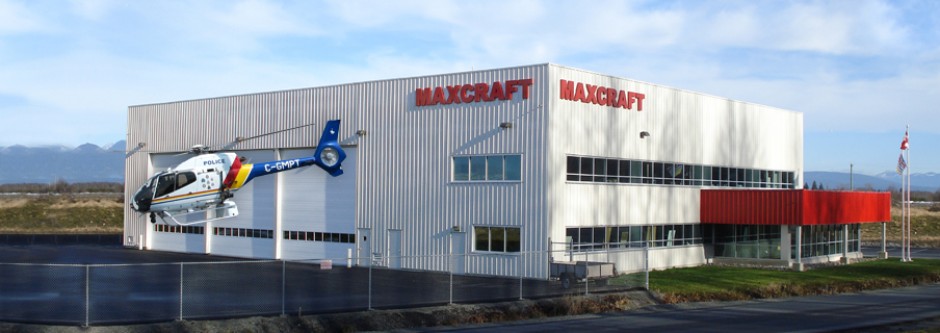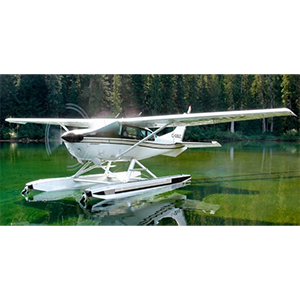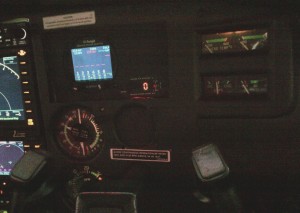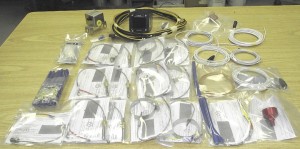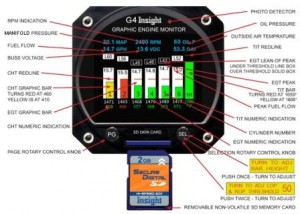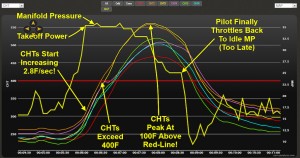Insight G4 Engine Monitor Review
by Steve Nunn
When I purchased my turbocharged Cessna 206 it came only with stock and basic engine gauges. I knew from reading on forums that Cessna had challenges trying to keep the Continental turbocharged engine cool when operating at the slower speeds of a float-equipped 206.
I also had the opportunity to attend the Advanced Pilot Seminar on engine management hosted by the company that invented the Gami balanced fuel injectors. This three day course in Ada, Oklahoma was well worth the trip and I highly recommend it to anyone flying a high performance piston engine aircraft. During that course we spent a lot of time in the classroom understanding our engines and operation and then proceeded to the most advanced engine test cell at GAMI headquarters.
Here we were able to put the poor engines through all sorts of abusive conditions so that we could better understand and see the results on the engine gauges, and most importantly, have a clear understanding on how we should operate our engines.
I quickly realized that I needed to get a graphic engine monitor for my new bird, and that I simply had to decide on which particular product. About the same time Insight Instruments, the original inventor of the graphical engine monitor, announced a new state of the art G3 graphical engine monitor. They really understood the modern process of engine management and had imbedded features that would ease the operation of my engine. They kindly loaned me one of their old instruments while I waited for the new G3 to get certified. At long last I had my hands on the G3 and it was everything I had hoped it would be – it had great graphics and fantastic features, but it was a bit hard to read the digital data from across the panel (honestly though, my mid-life eye sight issues might be a contributing factor).
In any case, Insight came to the rescue with the new enlarged 3/18” format G4 series. Now this is an engine monitor!
Let me take a step back and speak about the installation. This is a significant process; we are talking about installing over 20 probes on the engine, so I would suggest you find a shop that has done this type of work before. The work included mounting 6 EGT & CHT probes, TIT for the turbo, MAP, RPM, Fuel Flow, Oil pressure and temperature transducers, as well as a vibration sensor.
All of that has to come through the firewall and terminates neatly to the G4 display. Setup for the unit was minimal as the factory had already programmed all the temp limits and similar data to my specific engine type.
Operationally and in terms of ease of use, the unit excels over other offerings . On start-up you simply enter any new fuel added to the tanks and switch over the main graphics page. Engine run-up is eased as you can see visually if you have a fouled plug or bad magneto. During the critical take-off phase a quick glance will quickly tell you if all is well with engine operation. This alone could be worth investment, as an early detection of detonation could spell the difference between landing off-airport with a trashed engine or a simply backing off the throttle to halt detonation). Once I have leveled off, I pull the controls back to “park” my engine at its predetermined cruise configuration. Regardless of whether you’re a believer in Lean Of Peak operations, the leaning operation on the G4 clearly tells you the effect of your mixture knob.
After my APS course, that meant pulling the mixture back so that TIT reads under 1530 degrees, which brings my fuel flow from an astonishing 26 GPH in cruise to an economical 15 GPH! Most importantly with my hot running engine it brings all of the CHT’s down to below 380 degs and I regulate that temperature depending on conditions with my cowl flaps. Now that I have run through all the different engine power settings and observed those on my G4, I know exactly where to set my engine controls based on the G4 and the whole process now only takes seconds.
Lastly I should talk about ongoing operations. The key to these new powerful engine monitors is the ability to monitor the ongoing long-term health of your engine. Here is one instance I would like to share with you where the engine monitor helped tremendously. On a summer time departure the second flight of the day, I noticed I had one EGT probe indicating higher than normal. I was concerned that I may have a detonation issue but the CHT remained stable contradicting that concern, I pulled the power back and the EGT remained about average, CHT was normal. At least I knew I didn’t have a catastrophic problem and the EGT was just slightly higher. Upon landing I popped the cowling and there I noticed a very slight exhaust stain around the culprit cylinder and on a very close inspection I could see a hairline crack on the exhaust manifold. Without the engine monitor and its specific cylinder identification I would have flown blissfully along for many more hours until that crack became a significant problem damaging the cylinder or worse yet burning through an oil line. Thank you John and team at Insight!
The ability to trend monitor data from all of your flights is invaluable. The G4 records every second of every flight and stores all the data on a removable SD card. My procedure is I load that data on to my PC at every oil change and then quickly look for any changes in the trend. There are a few tools out there to view the data, but well known Mike Busch has written a great utility and has posted on his website for free! www.savvyanalysis.com
My conclusion is the G4 graphical engine monitor from Insight Instruments allows me to monitor not only the instantaneous health of my engine, but the long term trends due to its data monitoring capability. The combination of my balanced fuel injectors from GAMI and my advanced multi-probe monitor allow me to confidently operate my engine at a lower CHT temperature and fuel flow helping both my cylinders and my fuel bill at the pump! With the fuel totalizer linked to my GPS I know exactly how much fuel I will have upon landing at my destination sometimes allowing me to bypass a time consuming fuel stop. With the knowledge I have gained from the Insight G4 I strongly suggest all owners should consider an engine monitor and wouldn’t hesitate to recommend the G4.
Maxcraft Avionics is a leader in airplane and helicopter avionic system upgrades like the Garmin GTN series, including installation of everything from a basic VHF Radio and simple Garmin portable GPS all the way to TCAS, EFIS, and autopilot systems. We have the largest avionics facility in Canada and we have over 20,000 unique part numbers in our in inventory to repair your aircraft or upgrade your cockpit.
